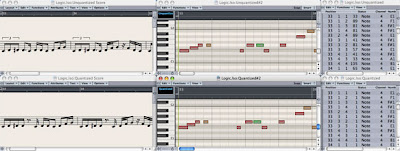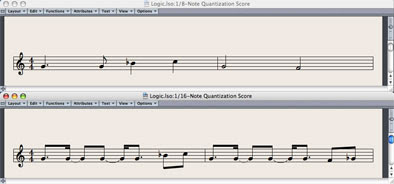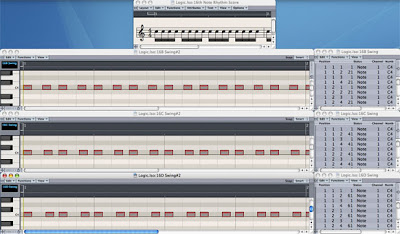A: Hello again. Logic Notes with Sze is back with its second article. As ICOM’s new m-Mobility students are working on their 1st sequencing assignment, I will be expanding on the basic concept of quantization - more specifically, to discuss about swing quantization.
Q: First of all, what is quantization?
A: Quantization is the auto timing correction of recorded MIDI notes (or events). It is a standard sequencer feature that pulls a note to the nearest quantization beat. For example, a rhythmic pattern that has been played unevenly or a little off the beat (early or late) will be “corrected” by pulling the notes to align perfectly with the selected quantization beat.

* Unquantized vs. Quantized: The top windows show the unquantized notes while the bottom windows show the quantized notes. Compare the differences... e.g. in the unquantized track, note the triplet notation, the loose alignment of notes to the Matrix grid and the somewhat random pulses (ticks) in the Position column.
* Unquantized (mp3)
* Quantized (mp3)
Quantization can do wonders for the amateur musician if the MIDI notes were loosely played. It can help tighten the rhythms but it is not magic – notes that have been recorded too far off the beat can be quantized the wrong way (i.e. pulled to the wrong quantization beat)!
So what do you do if that were to happen? Well, simply undo or delete the recording and try again.
Q: How do I select the proper quantization value?
A: In most cases, you can simply choose the smallest rhythmic beat/subdivision in the MIDI recording as the quantization value.

Selecting Quantization Values: The top example can be quantized to an 8th note beat while the bottom example can be quantized to a 16th note beat.
Q: How is swing quantization different from the normal quantization?
A: Swing quantization pulls MIDI notes to align to uneven rhythmic beats whereby every 2nd beat is delayed by a preset value. This is in contrast to normal quantization, which aligns the notes to even rhythmic beats (e.g. swing 8th as opposed to straight 8th notes).
Q: What is the difference between the 16B Swing and say, the 16D Swing settings in Logic?
A: The various settings differ in the amount of swing that is applied to the quantization beats. The following examples best illustrate the concept:
• 16A Swing is straight 16th note quantization, i.e. at 50% swing (every beat is rhythmically even). It is also the same as the 1/16-Note setting.
• 16B Swing is 54% swing quantization - every 2nd beat is delayed by 20 pulses (ticks).
• 16C Swing is 58% swing quantization - every 2nd beat is delayed by 40 pulses (ticks).
• 16D Swing is 63% swing quantization - every 2nd beat is delayed by 60 pulses (ticks).

Swing Intensities: The editing windows show the 16th notes quantized with (from top to bottom) 16B, 16C and 16D Swing settings. Compare the graphical note placements on the Matrix grids and the numerical delays in the pulses (ticks) column.
Q: What does swing quantization sound like?
A: Personally, I find that swing quantization is less stiff and has a better feel to it (more musical).
* Straight Quantization (mp3)
* Swing Quantization (mp3)
Q: What is the best swing quantization setting?
A: Mild to moderate swing settings (e.g. 16B-16D Swing) usually sound the best. But the most suitable setting will vary according to the actual musical context – try different settings and let your ears be the judge.
* 16B Swing (mp3)
* 16C Swing (mp3)
* 16D Swing (mp3)
Listen to entire sequence:
* MIDI Tutorial (mp3)
Q: What else should I be aware of?
A: Be wary of applying multiple swing quantization settings on different tracks. This can easily sound like slack timing, especially if there are rhythmic kicks in the tracks.
Q: Are there any Logic Notes updates available for downloading?
A: Yes, there is a minor update (v1.1) to the Logic preferences file in the Logic 7 downloads section - both the Metronome Tonality and Volume settings have been increased to make the click more audible.
If you have not already adjusted those metronome settings yourself, then this Logic Notes update may just help you keep time better during recording. Happy sequencing, be musical and just swing it right!
* Edited/recorded from the Emagic Logic 5/Logic 6 MIDI Tutorial sequence.
____________________________________________________________________________________
Logic 7 downloads:
OR
OR
__________________________________________________________________

No comments:
Post a Comment